Affiliate disclosure: This post may contain affiliate links. Please see our Privacy Policy.
Calendula tincture is the ultimate tincture for skin health. It has wonderful antimicrobial, antiseptic, antifungal, and anti-inflammatory properties. It’s excellent for treating minor issues like cuts, abrasions, insect bites, and chapped skin. This remedy is good for other parts of the body, too. Calendula is high in vitamin A and antioxidants and is ideal for immune support. This tincture is simple to make, even for beginner herbalists.
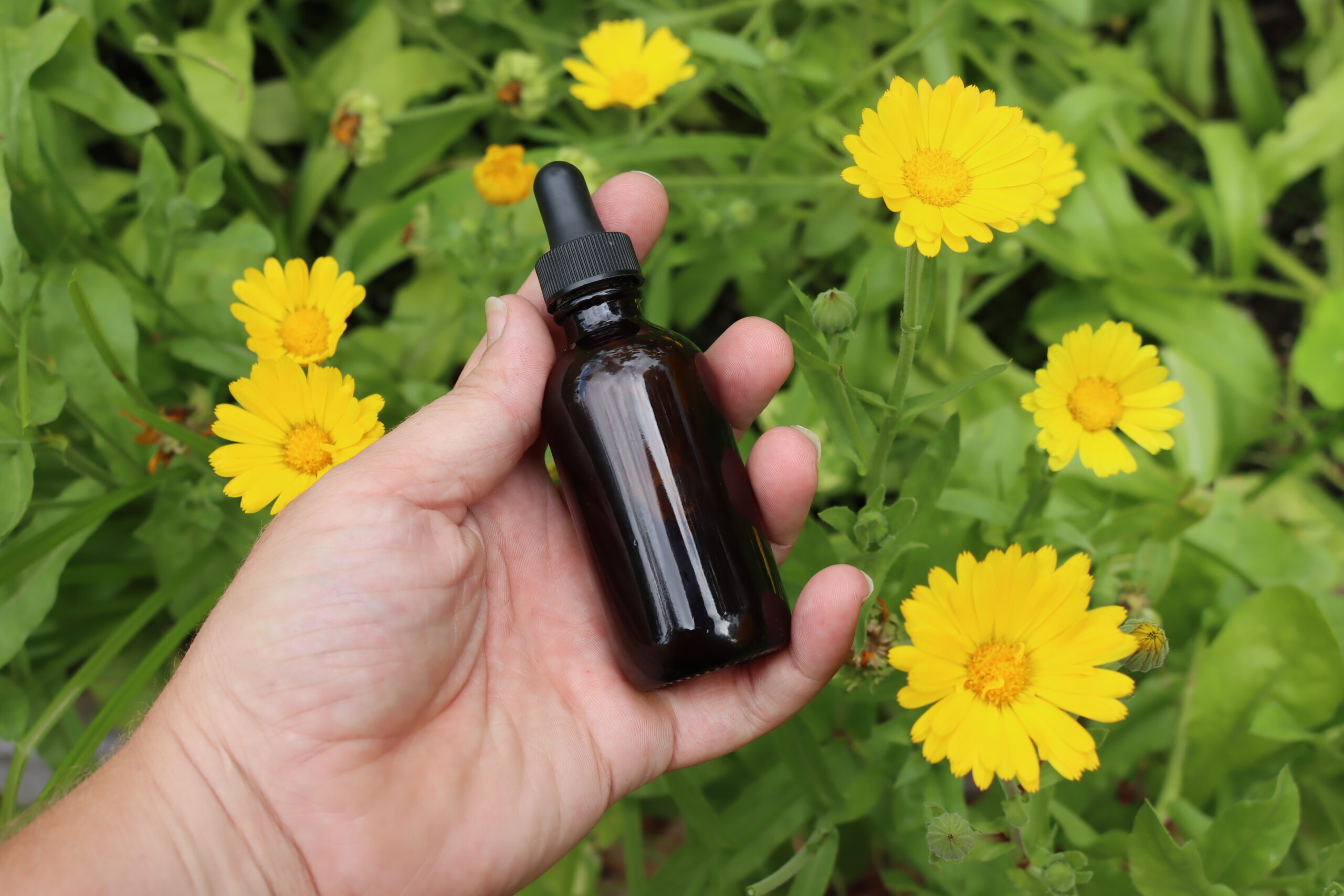
This bright and cheerful flower is among the better-known skin care herbs.
When dealing with dry, irritated skin, minor wounds, or burns, calendula can help relieve discomfort and speed up healing. It can also come to your aid for internal issues like viruses, helping to decrease inflammation and boost your immune system.
Those who are pregnant, trying to become pregnant, or breastfeeding should not use or consume calendula. Calendula may interfere with conception and, in theory, could cause abortions.
People who are sensitive to plants in the Asteraceae/Compositae family like daisies, ragweed, or marigolds, may also be sensitive to calendula. Use caution when trying calendula for the first time.
This herbal ally is a beauty in the garden! Calendula is an annual that grows 8 to 24 inches tall and has cheerful orange blooms.
Calendula is an easy-to-grow warm-weather herb. Growing calendula from seed is a reliable way to start plants each spring, and the plants tend to self-sow after the first year.
Direct sow your calendula seeds after the danger of frost has passed. Calendula may self-seed, but saving seeds is the best way to ensure you can grow some each year.
For herbal preparations, you want to harvest the flower heads when they’ve just reached full bloom and are fresh and vibrant. It may be the most stunning herb you’ll harvest this season; there’s nothing like a basket of calendula blossoms!
You can use your calendula blooms fresh or dry them for later use.
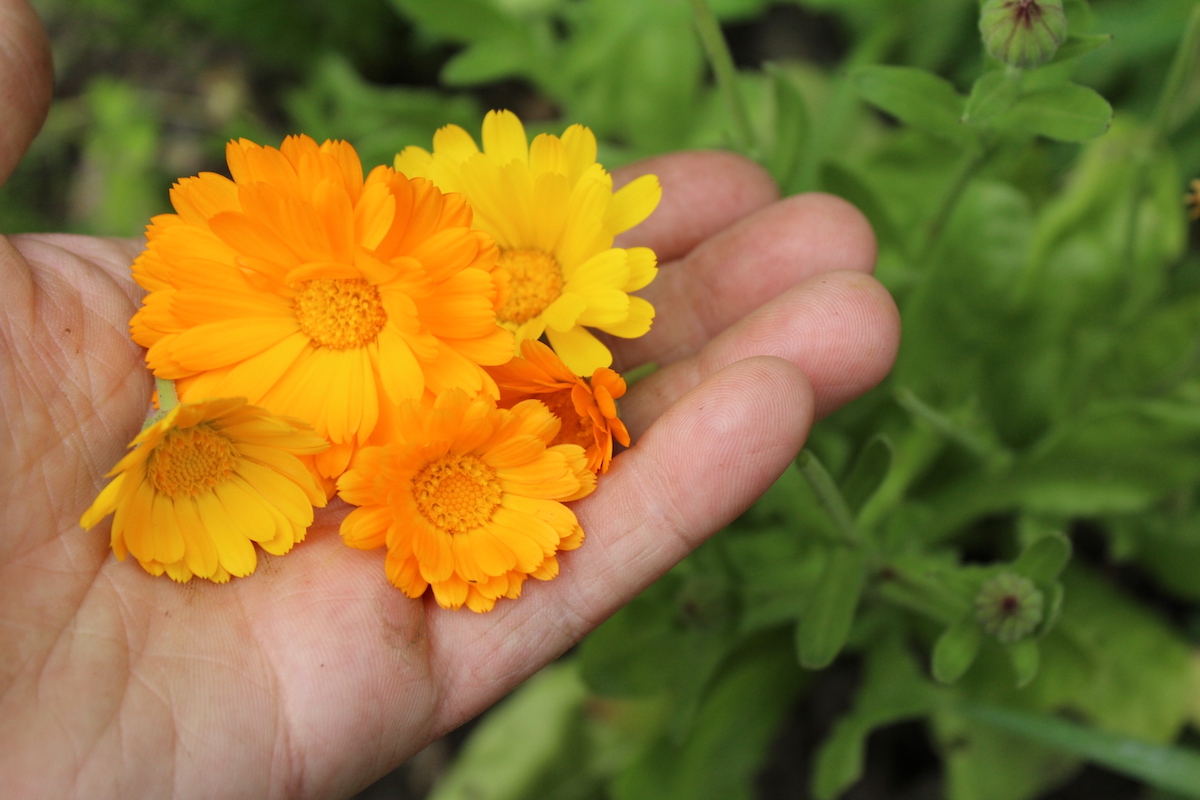
(Always consult your doctor or a clinical herbalist before trying any new herbal remedy, as there’s always the possibility of unintended consequences, allergic reaction, or interactions with other medication. If you’re harvesting wild plant material, make sure you’re 100% confident in your identification and consult multiple sources for your ID. The following is based on my research and experience, but I don’t claim to have any certifications that would qualify me to advise you on your health. Please do your own research and always verify with multiple reputable sources.)
Benefits of Calendula Tincture
You may already be familiar with calendula’s numerous skin-healing properties as it’s a common ingredient in lotions, creams, and other skin care-related productions. While calendula is mostly applied topically, it can still be taken as an extract in tincture form.
What makes calendula so powerful? Similar to echinacea, its impressive concentration of compounds with antioxidant properties: flavonoids, triterpene saponins, and carotenoids. These compounds contribute antimicrobial and anti-inflammatory responses, which helps to slow down the spread of infection. The effects of these antioxidants against free radicals have largely been researched in animal studies, but the results show some promise.
Like I said, calendula is almost always used topically as a salve, rinse, or oil. However, it can be taken as a tincture to promote lymphatic drainage, especially with ear infections. Similarly, calendula tincture can improve immune response against inflamed membranes in the mouth and throat which in turn helps soothe sore throats from laryngitis, tonsillitis, and coughs due to its antimicrobial properties.
Calendula isn’t just for humans! Used as a spray, calendula is a safe and effective way to treat scrapes, wounds, and dry, itchy patches on dogs (but not cats, as calendula is toxic to cats). You can even add a few drops of calendula extract to your dog’s food to treat inflammation and urinary tract infections.
Keep in mind, calendula is in the same family as ragweed, daisies, marigolds, and other plants in the Asteracea/Compositae and should be avoided if you’re allergic or suffer from seasonal allergies.
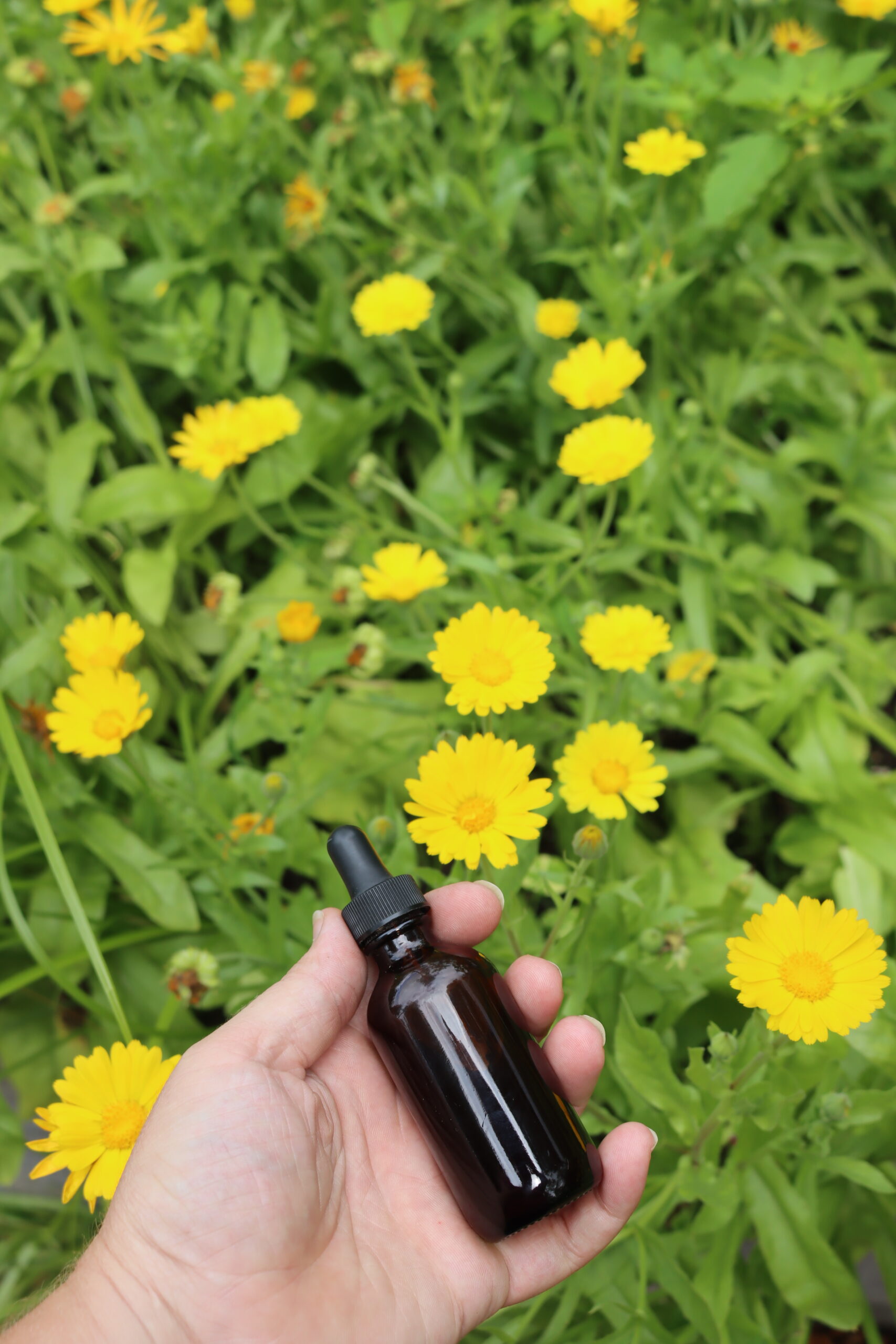
Calendula Tincture Uses
Herbalists use calendula tinctures both topically and internally to treat various ailments.
Topically, calendula tincture is used for:
- Cleaning and Treating Small Cuts and Abrasions
- Soothing Insect Bites, Chapped or Irritated Skin
- Reduce Skin Inflammation
- Treating Minor Burns
- Fighting Fungal Infections
Internally, Calendula tincture is used to:
- Boost the Immune System
- Treat Colds, Flu, and Other Viruses
- Treating Stomach Upset and Ulcers
- Treat Yeast Infections
- Support Oral Health
Additionally, the herb is currently being investigated for its potential:
- Relieve Menstrual Cramps
- Combat Cancer Cells
In these cases, research is ongoing, and more work is needed to establish whether or not the benefits are scientifically significant.
Benefits of Calendula Tincture
Herbalists have used calendula to treat various skin issues and external wounds for hundreds of years. During the American Civil War and WWI, soldiers and field surgeons used calendula as an antiseptic for open wounds.
Today, calendula is still commonly used in skin care products, especially those designed to combat irritation from diaper rash, dermatitis, eczema, fungal infections, and wounds.
Unfortunately, dermatitis is a common side effect of radiation therapy used to treat certain types of cancer. Researchers in one promising study from 2004 treated groups of patients undergoing radiation therapy for breast cancer with calendula or the traditional treatment, trolamine. Researchers reported that patients receiving the calendula had significantly lower occurrences of acute dermatitis and reported reduced pain.
Beyond being soothing, calendula also fights bacterial and fungal infections of the skin. One 2008 study found that the oil in calendula flowers is effective at inhibiting 23 strains of Candida yeast, a fungus that commonly causes skin, oral, and vaginal infections. In a test tube study, calendula also inhibited the growth of leishmania, a parasitic protozoan that causes Leishmaniasis, a disease known for causing skin sores that eventually damages the liver, spleen, and bone marrow.
Calendula’s bacteria-fighting effects may extend to oral health as well. In a 2013 study, researchers divided 240 people with gingivitis into two groups: one group received calendula mouthwash, and the others received a placebo mouthwash (water). After six months, the calendula group saw a 46% reduction in inflammation levels.
Traditionally, calendula was also used to soothe stomach ulcers, cramps, and gastrointestinal issues. Today, some research is supporting these traditional practices. A 2015 study working with rats found that calendula showed significant antiulcer activity and increased the mucus lining in the stomach.
Calendula may help with external ulcers, too. A 2016 study looking at 57 people with non-healing venous leg ulcers (VLUs) found that 72% of the group given calendula extract experienced complete healing after 12 weeks compared with just 32% of the control group.
The proper dosage of calendula tincture varies with the intended use. Generally for external use, calendula tincture is usually diluted with distilled water in a 1:2 ratio. The diluted mixture is sprayed on the affected area or applied with a clean piece of cotton or gauze. It can be diluted the same way for a gargle for oral health or wounds.
There’s also some evidence that calendula may combat certain types of cancer cells, though it should not be used as a substitute for cancer treatment, and research is ongoing.
For internal use, herbalists generally recommend taking one dropper full of calendula tincture one to three times per day.
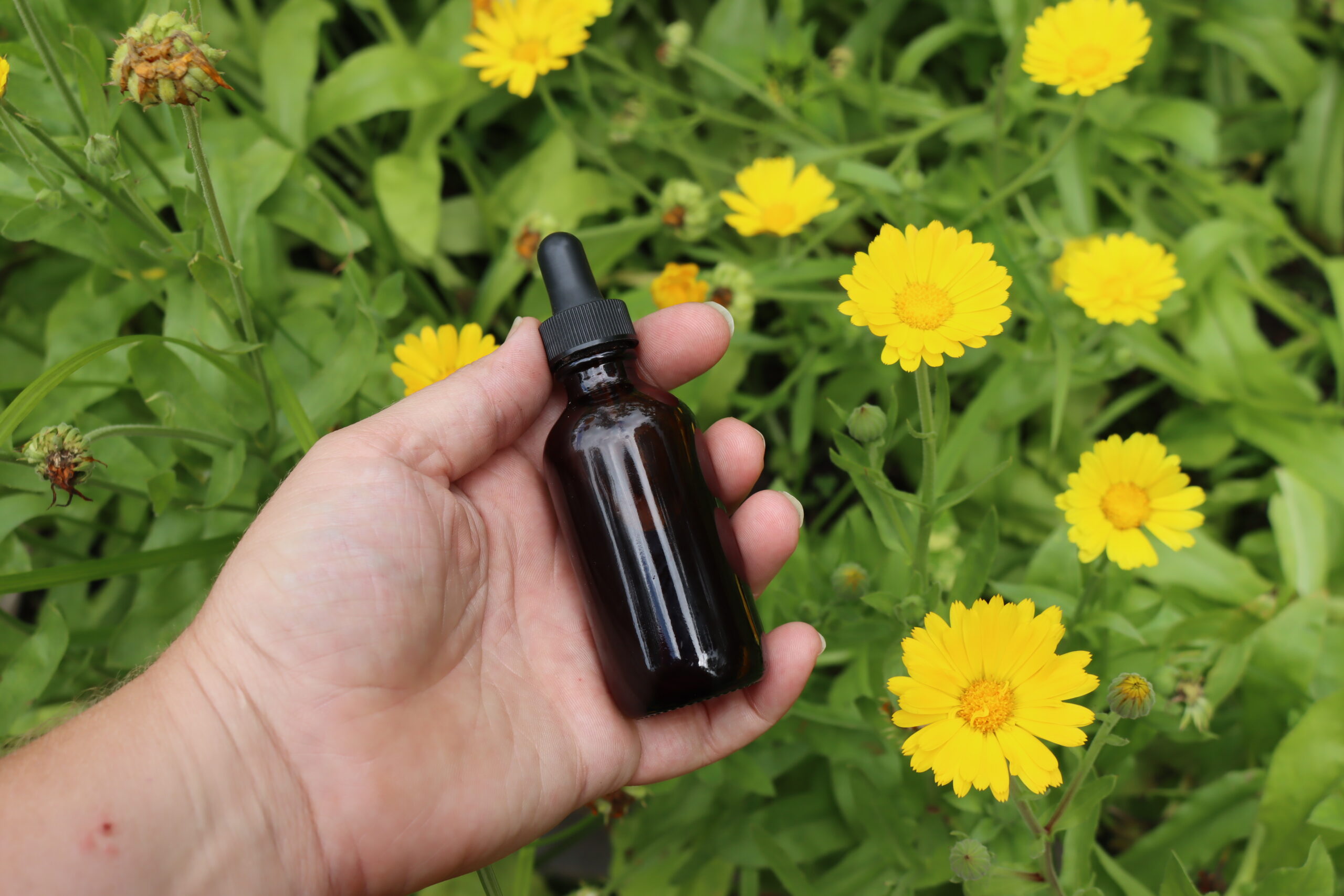
Parts Used for Tincture
Calendula tincture is a beautiful tincture to make because you get to work with the blossoms! If you’re harvesting fresh calendula, wait until the blooms are fully open, but harvest them before they begin to fade.
In many remedies, you use just the calendula petals because the other parts are bitter. However, for the tincture, you want the entire flower head, including the green sepals or base of the flower.
The flowers look beautiful in whole, but for the best results, you want to chop or tear them up a bit. Processing the flowers increases the surface area and allows the alcohol to absorb better to create your tincture.
You can also use dried calendula flowers you harvested previously or purchased. Calendula may be available from a local farm, but you will likely have to purchase it online. One of our favorite herbal suppliers, Mountain Rose Herbs, carries whole-dried calendula flowers.
How to Make Calendula Tincture
To make a Calendula tincture, you’ll need the following ingredients and equipment:
- Fresh or Dried Calendula
- Vodka* (or any other palatable alcohol that’s at least 80 proof/40 percent — you can use gin, rum, or whatever you prefer)**
- One-pint mason jar with lid (amber or blue glass is ideal, but as long as you keep the tincture away from light at all times, it won’t make a difference)
- Funnel
- Cheesecloth
- Fine mesh sieve
- Amber glass tincture bottles (with dropper)
- Optional: Spray Bottles or larger bottles for mouthwash
*The Herbal Academy’s tincture-making course specifically recommends using 70 to 95% alcohol for fresh calendula or 60% alcohol when working with dried calendula.
**Never use isopropyl/rubbing alcohol for tinctures (or any other remedy you plan on ingesting). Even in small amounts, this type of alcohol is toxic and meant for external applications only.
To make the tincture, fill your jar ⅔ full with fresh calendula or about ½ full with dried calendula.
Then, cover your calendula with alcohol, making sure it covers the calendula. It’s okay if the dried calendula floats at first. Seal your jar with an airtight lid so that the alcohol doesn’t evaporate.
Store your tincture in a cool, dark place that’s easy to access. Each day, take your tincture out and give it a gentle shake. Don’t worry if you miss a couple of days. Tinctures are very forgiving.
Stick to your shaking schedule for about 4 to 6 weeks. Then, you can decant your tincture.
To decant your tincture, line a funnel with a few layers of cheesecloth and strain your tincture. You can strain your tincture directly into finished bottles or into another jar, let it resettle, and strain it again for a clearer finished product. Make sure you squeeze the flowers in the cheesecloth to extract all of the liquid!
Once you’re happy with your tincture, you can add it to tincture bottles or dilute it into spray bottles for topical use or a large bottle for mouthwash. Label all of your finished products with the name, date, and dosage. Masking tape and a marker are great for this because the tape is easy to remove, allowing you to reuse the bottles.
Calendula Tincture Dosage
For an exact dosage specific to your body and needs, I’d suggest consulting a clinical herbalist.
Here are some general calendula tincture recommendations:
For internal use, take one dropper full of calendula tincture up to three times per day.
For external use dilute your calendula tincture 1:2 with clean water. Add this mixture to a spray bottle or apply to the skin with clean cotton balls or gauze.
To create a calendula oral rinse, dilute the tincture 1:2 with clean water and place it in a larger jar. This can be used daily for oral health or as needed to treat specific issues.
Calendula Formulations
Calendula is one of the most commonly used skin care herbs, but a few other excellent herbs also work well with it. To help reduce inflammation and irritation, consider using chamomile, turmeric, and aloe vera tinctures with your calendula tincture.
If you need calendula for immune support and fighting viruses, consider pairing it with other potent immune-boosting remedies like echinacea tincture, elderberry tincture, or oregano tincture.
If you’re interested in the science behind combining herbs to enhance their effectiveness, I’d recommend taking this online course in Mastering Herbal Formulations from the Herbal Academy. It covers the science of blending herbs into homemade formulations in detail.
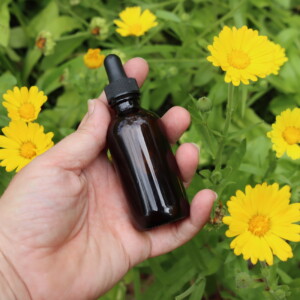
Calendula Tincture
Equipment
Ingredients
- Calendula Flowers Fresh or Dried
- Neutral Spirit such as vodka*
Instructions
- Begin by filling a clean mason jar about three-quarters of the way with fresh calendula flowers, or half full if you're using dried calendula. You can find dried calendula at most herbal supply stores.
- Pour alcohol over the calendula, ensuring that the plant material is fully submerged. The alcohol should completely cover the flowers or petals.
- Secure the lid tightly on the jar and give it a gentle shake. Then, place the jar in a cool, dry place, away from direct light. Allow the calendula to steep in the alcohol for about 6 to 8 weeks.
- Every few days, give the jar a light shake to help with the extraction process.
- Keep an eye on the alcohol level in the jar, and if the plant material starts to rise above the liquid, top it off with more alcohol to keep it fully covered.
- When the tincture is ready to strain, line a funnel with cheesecloth and position it into the neck of a dark amber glass bottle. Carefully pour the tincture and calendula mixture through the cheesecloth, pressing gently to extract all the liquid into the bottle.
- Label your tincture with its ingredients, the date it was made, recommended dosages, and any suggested uses. Store the finished tincture in a cool, dry place, away from light, to preserve its potency.
Notes
Calendula Glycerite (Alcohol Free)
If you prefer to make an alcohol-free tincture, you can create a glycerite. To do this, cover your dried plant material with a mixture of 3 parts vegetable glycerin to 1 part distilled water, instead of alcohol. Dried calendula is commonly available from herbal suppliers and is often used in place of fresh flowers. If you are using fresh calendula, simply use all glycerin and omit the water. Like an alcohol tincture, a glycerite will require daily shaking as it infuses. Otherwise, follow the same steps you would for a traditional tincture.Yield
The yield will vary depending on whether you're using fresh or dried herbs. When using fresh plant material, you'll typically end up with just a little more tincture than the alcohol you started with. With dried herbs, however, some of the alcohol will be absorbed by the plant material, so you’ll yield slightly less. For a quart-sized jar, you'll need around 2-3 cups of alcohol, and for a pint-sized jar, you'll need about 1 to 1 ½ cups. The amount of alcohol required can also depend on how tightly you pack the herbs into the jar. Be sure to keep the plant material fully submerged throughout the infusion process to ensure optimal extraction.Disclaimer on Homemade Herbal Remedies
I’ve been foraging wild medicines and treating my family with herbal remedies for the past 20 years, but I’m self-taught. Be aware that I am not a clinical herbalist, and this is based on my own research and personal experience using medicinal plants. I do not claim to have the experience that’d qualify me to advise you on your health, and I’m only providing this as a reference to encourage a broader interest in medicinal plants.
Please use this as a jumping-off point, but always do your own research and verify anything you read with multiple sources.
It’s always possible to have an adverse reaction to any medicinal herb, and plenty of people are allergic to even gentle herbs like chamomile. Always consult your doctor or a certified herbalist before trying any new medicinal plant. Often, they can have unintended reactions in combination with other herbs and supplements, and many herbs have side effects even when they are effective for their intended purpose.
If you are seriously interested in herbal medicine, I’d suggest investing in a course in herbal medicine, and I’d recommend any of the online courses put out by the Herbal Academy of New England. Specifically, the introduction to herbal medicine course and the family herbalist group of courses.
They also have a mushroom course, covering both medicinal and edible mushrooms, and a Botany and Wildcrafting Course. I’ve taken both and they’re informative, inspiring, and artfully presented.
Herbal Tinctures
Interested in making other homemade herbal tinctures?
Herbal Medicine Making
Herbal medicines don’t stop at tinctures! Learn how to make more homemade medicine…
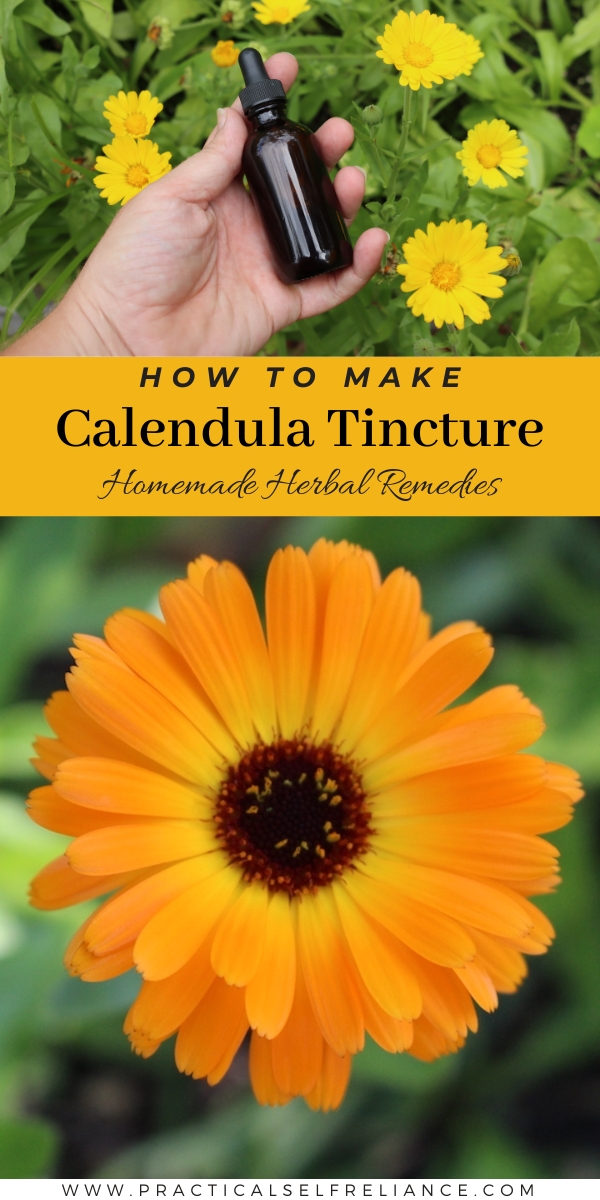
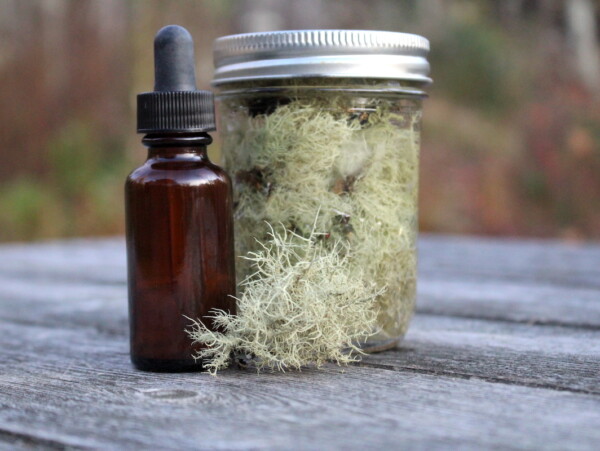
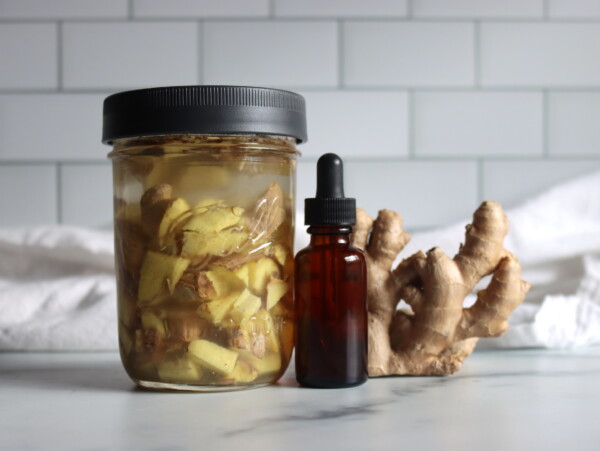
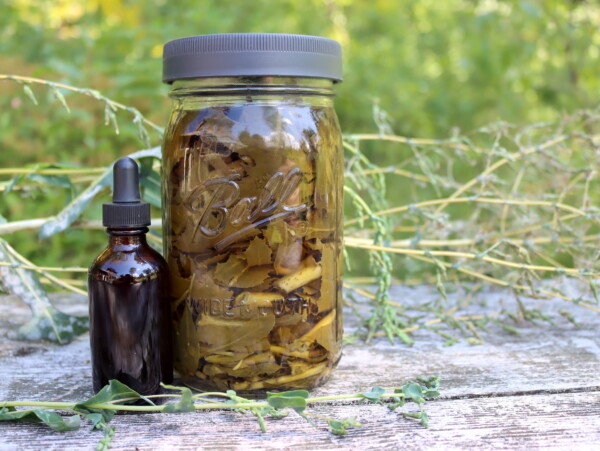
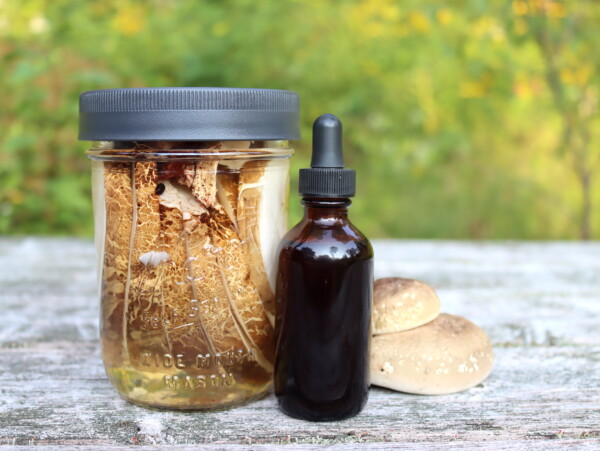
Thank you for your insightful information and easy to follow instructions on how to make Calendula tinctures! I’m excited to give it a try!